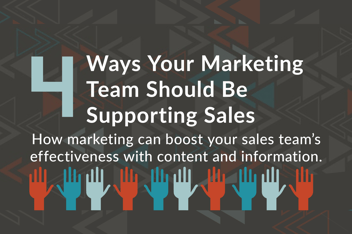Are You Marketing What Sales Is Selling?

You know, and I know, that marketing plays an essential role in developing leads and in developing demand for your company’s products and services. Marketing content sets the stage for the sales team to close deals that drive corporate achievements.
But even the best marketing content is useless if it isn’t focused on the right products, services, benefits and customers. If what you are marketing isn’t what sales is selling, everyone will miss the mark.
So before you run with the next brilliant marketing campaign idea, content distribution channel, or catchy tagline, consider a few questions that can help you determine if you are putting your resources where they can have the biggest impact on successful sales.
Where does your company generate the most revenue? What generates the most profit?
And do you understand the difference?
I’m sure most do, but sometimes it’s worth a little reminder. Revenue is money coming in — from sales of products or contracts for services. Profit is what remains of that income after expenses are taken out. The greatest profits don’t always come from the products or services that generate the most revenue.
Consider this:
At a full-service restaurant, the bulk of the revenue comes from the sale of food. But the cost of ingredients and labor to make and serve a meal takes a hefty bite out of the gross revenue, leaving average profit margins somewhere between 1 and 15 percent, depending on the type of restaurant. (Source)
But when you look at individual menu items, a few generate a much higher profit margin than others. Soda, for example, has many fewer expenses involved and often provides up to a 90 percent profit margin — in other words, customers pay about 10x what the cost of production was. (Source)
Marketers need to understand how both high revenue products and high profit products fit into their company’s overall financial picture.
What are the key products sales is focused on?
We’ve talked many times about how important it is for sales to be at the table when marketing creates strategies and campaigns for the coming year (see examples here and here), so this should be a no-brainer. If sales is providing input, and marketing is listening, the decision about what to promote during any period of time should be a joint effort. But if your teams aren’t yet to that level of collaboration, at least have a meeting to touch base about where sales if focusing their efforts, both in the short term (e.g. moving an older model of a product through the chain because a new one is being introduced) and over time.
Even though marketing should be developing content to support all products or services, as well as the company’s over-arching brand position, prioritize projects that can help sales and the company achieve goals now.
What benefits do those products/services provide?
Both salespeople and marketers need to understand that they aren’t selling the product or service as much as they are selling the benefits that product or service provides to the buyer. While the contract may be for a healthcare notification and communication service, what the dentist’s office is really looking for is patients who keep their appointments and make payments on time. The logistics manager isn’t just purchasing mapping software, they are purchasing a reduction in training time and improved fuel efficiency. Even in my industry, clients are hiring for the website design and content creation — they are hiring us for increased lead generation, more sales closures and a strong brand position in the marketplace.
Create content based on benefits and solving problems, not simply a list of features.
How can you support sales?
As your marketing team creates content, think about how that content can be used throughout the sales funnel, not just in the awareness stage. Plan from the beginning to repurpose and redistribute content in ways that address new contacts, active leads and even current customers.
Again, involving sales in the planning process can bring new ideas to table about everything from using blog graphics in presentation booklets to creating templates and checklists that mesh with various levels of service offerings. And be sure that you let the sales team know what content you already have available, so they can utilize it in personalized communications.
If you consider all of these questions before getting too deep in your next marketing content campaign or project, you will ensure you are focusing your energy, resources and audience on the areas that achieve corporate goals. After all, you’re all on the same team. Get more tips on creating a positive working relationship between marketing and sales in The Complete Guide to Unifying Marketing & Sales.
-1.png?width=1652&height=294&name=Jones(RGB)-1.png)











